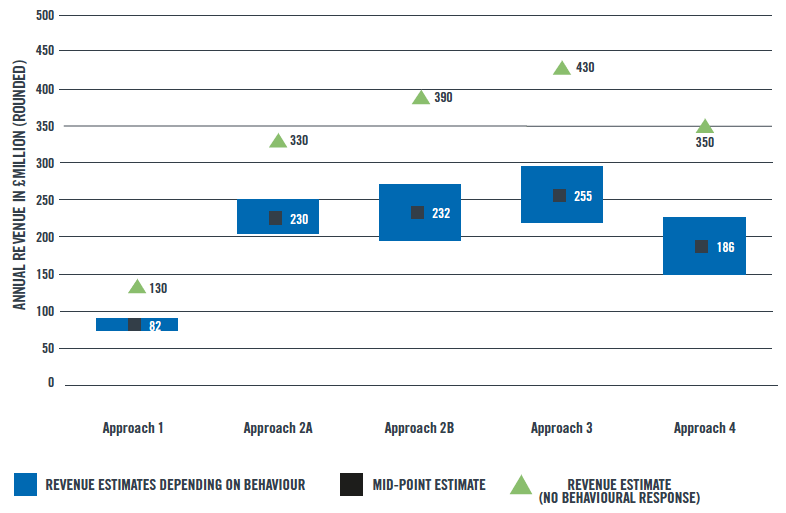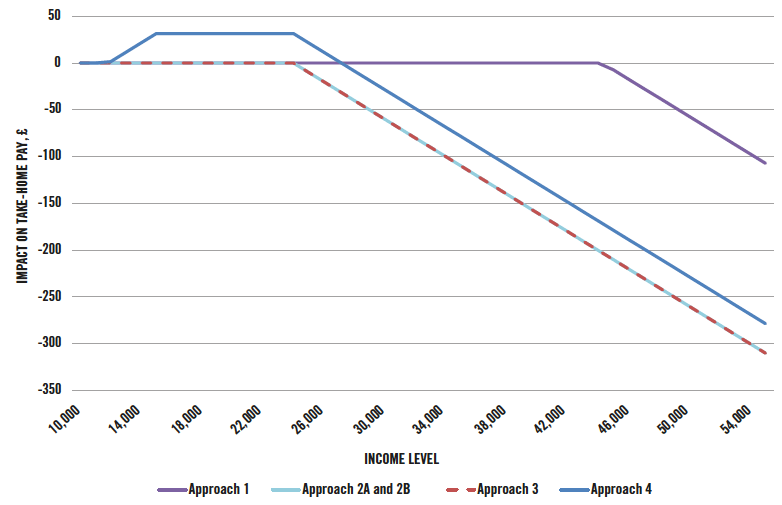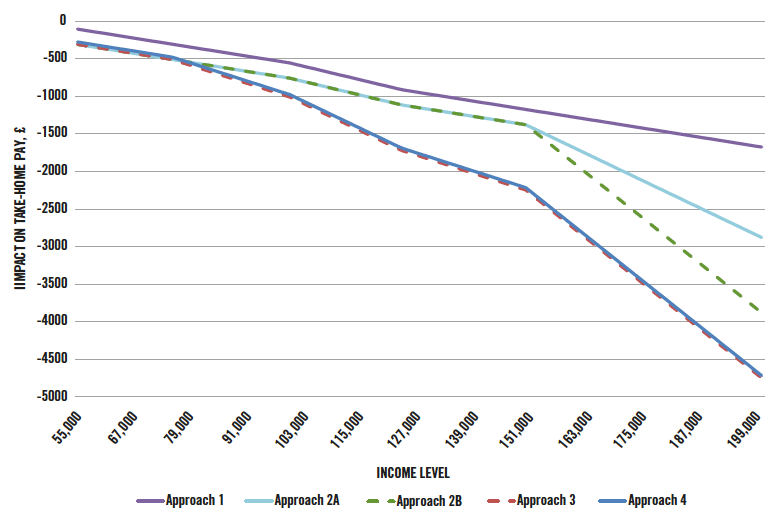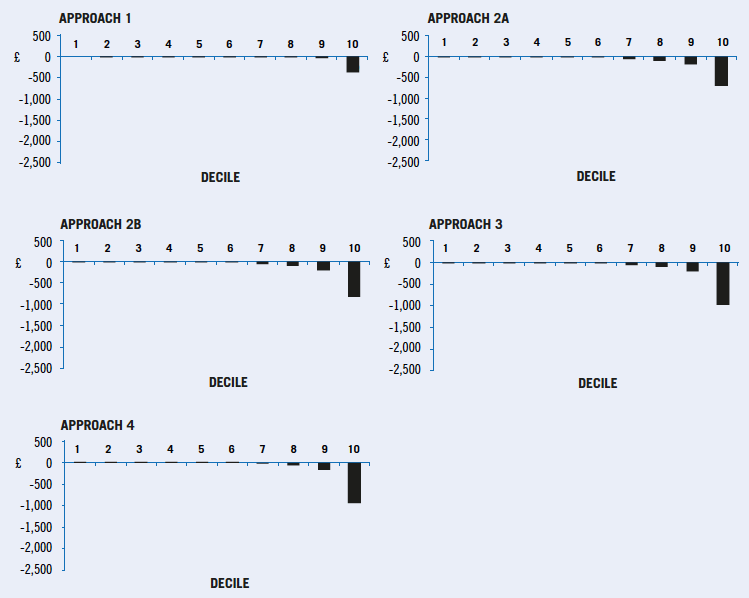The role of income tax in Scotland's budget
A discussion paper that aims to provide useful background to help inform the debate on future use of the income tax powers devolved to the Scottish Parliament.
7. Alternative approaches
The chapter is split into two sections. Section 7.1 describes a set of alternative and illustrative approaches. Section 7.2 estimates the revenue implications and impact of the approaches.
7.1. Four alternative approaches
In the light of the above, while all of the parties’ proposals have interesting features, in order to develop the debate, we set out four alternative approaches that we believe could better meet the four tests. These do not constitute firm policy proposals - the Scottish Government’s tax policy will be set out in our Draft Budget but they are intended to provide illustrative examples as a basis on which all parties can begin the discussion.
These alternative approaches are primarily based around tax regimes with different numbers of bands and are set out in more detail below. Within each alternative, there are ways to vary them that might raise more revenue, such as adding an additional penny to a rate or changing bands. A further variation, which could be applied to any of the approaches, would be not to increase the HRT by inflation (an inflationary increase is currently assumed) but either to freeze the HRT in cash terms or to vary it on a scale between a cash freeze and an inflationary increase. This latter variation would increase the revenue raised by up to £90 million (see Box D).
Many countries successfully operate tax systems with more than three income tax bands. [27] We acknowledge that if proposals to change tax bands are brought forward it will be important to engage extensively with HMRC to minimise any change in the administrative burden on self-assessment taxpayers and on business. The efficiency of the tax system is, therefore, something which we will consider in the upcoming debate.
Approach 1: A tax regime with three bands
Approach 1 (see Table 10) would keep the three existing income tax bands but add one penny on both the higher and additional rates of income tax. The basic rate would be left unchanged at 20p. The HRT would increase in line with inflation.
Table 10: Approach 1
| Gross Income | Tax Rate | Number of people in band |
|---|---|---|
| £11,850 to £44,290 | 20% | 2,165,000 |
| £44,291 to £150,000 | 41% | 346,000 |
| above £150,000 | 46% | 20,000 |
This approach would increase income tax rates for the highest earning 8% of Scottish adults. As a result, 2.2 million Basic Rate taxpayers would pay no more tax than they do under the current system.
While this approach adds 1p to the Additional Rate, a variation of this approach would be to increase the Additional Rate by 3p or up to 5p instead. Estimates assuming increases in the Additional Rate of 3p and 5p are included under Approach 2.
Approach 2: A tax regime with four bands
Approach 2 (see Table 11) would introduce a new income tax band for low earners based around the median income, resulting in four income tax bands as opposed to the current three. Earnings between £11,850 and £24,000 would continue to be taxed at 20p. Earnings between £24,001 and £44,290 would be taxed at 21p and earnings between £44,291 and £150,000 would be taxed at 41p.
In taking this approach, the Additional Rate is increased firstly by 3p to 48p (Approach 2A) and then by 5p to 50p (Approach 2B).
Table 11: Approach 2
| Approach 2A | Approach 2B | ||||
|---|---|---|---|---|---|
| Gross income | Tax Rate | Number of people in band | Gross income | Tax Rate | Number of people in band |
| £11,850 to £24,000 | 20% | 1,267,000 | £11,850 to £24,000 | 20% | 1,267,000 |
| £24,001 to £44,290 | 21% | 898,000 | £24,001 to £44,290 | 21% | 898,000 |
| £44,291 to £150,000 | 41% | 346,000 | £44,291 to £150,000 | 41% | 346,000 |
| Above £150,000 | 48% | 20,000 | Above £150,000 | 50% | 20,000 |
Under Approaches 2A and 2B, around 1.3 million Basic Rate taxpayers - more than half - would not pay any more tax than they would under the current system.
Approach 3: A tax regime with five bands
As has been suggested in the context of the UK income tax system, it would be possible to split the higher rate band. Approach 3 (see Table 12) would split the current higher rate band at £75,000, further increasing the tax liability for the top 4% of Scottish income taxpayers.
Earnings of between £44,291 and £75,000 would be taxed at an extra 1p compared to the current system. Earnings between £75,001 and £150,000 would be taxed at an extra 2p at a rate of 42p. The HRT would increase in line with inflation.
Table 12: Approach 3
| Gross income | Tax Rate | Number of people in band |
|---|---|---|
| £11,850 to £24,000 | 20% | 1,267,000 |
| £24,001 to £44,290 | 21% | 898,000 |
| £44,291 to £75,000 | 41% | 266,000 |
| £75,001 to £150,000 | 42% | 79,000 |
| Above £150,000 | 50% | 20,000 |
As above, 1.3 million taxpayers, more than half of Basic Rate taxpayers, would pay no more tax than under the current system.
Approach 4: A tax regime with six bands
Approach 4 (see Table 13) would increase the number of income tax bands from three to six. Earnings of between £11,850 and £15,000 [28] would be taxed at 19p, as opposed to 20p at present. Earnings between £15,001 and £24,000 would be taxed at the 20p rate as they are now. The other rates and bands are essentially the same as under Approach 3.
Table 13: Approach 4
| Gross income | Tax Rate | Number of people in band |
|---|---|---|
| £11,850 to £15,000 | 19% | 386,000 |
| £15,001 to £24,000 | 20% | 881,000 |
| £24,001 to £44,290 | 21% | 898,000 |
| £44,291 to £75,000 | 41% | 266,000 |
| £75,001 to £150,000 | 42% | 79,000 |
| Above £150,000 | 50% | 20,000 |
This means that 1.4 million taxpayers earning below £27,000 would pay less tax than they do now.
Table 14 compares the impact of the alternative approaches on the 2.5 million income taxpayers in Scotland by comparing the tax they would pay in 2018-19 with that under the current tax regime. [29]
Under Approach 1, around 2.2. million Basic Rate taxpayers, or 86% of taxpayers, would pay no more tax than they do under the current system. Approaches 2 and 3 would result in half of all Scottish taxpayers seeing no change in their tax liability and half paying more. Under Approach 4, around 57% of Scottish taxpayers, i.e. all individuals earning less than £27,000, would pay less tax than they do under the current regime. The remaining 43% of taxpayers would pay more.
Table 14: Impact On Scottish Taxpayers Of Changes To Rates/Thresholds
| Approach | Taxpayers (million) | Percentage of Scottish taxpayers who pay | ||
|---|---|---|---|---|
| same tax | more tax | less tax | ||
| 1 | 2.53 | 86% | 14% | - |
| 2A/2B | 2.53 | 50% | 50% | - |
| 3 | 2.53 | 50% | 50% | - |
| 4 | 2.53 | - | 43% | 57% |
It is also important to remember that there are currently 2 million individuals, or 44% of adults in Scotland, who do not pay income tax as they earn less than the PA. These people would be unaffected by each of the approaches outlined above.
7.2. Revenue implications and impact of the proposals
The analysis of the alternative approaches uses the same model, data sets and underlying assumptions as set out in Chapter 5 in order to ensure consistency. All revenue figures are compared to the income tax rates and bands shown in 2017-18 with the PA and the HRT both increased in line with inflation.
Revenue implications
Chart 8 illustrates the impact on revenues of the alternative proposals in 2018-19. It shows the revenues both with and without estimated behavioural change. Further details are in Annex A. All the proposals would raise extra revenue for the Scottish Budget, albeit to different degrees:
- Approach 1 (three bands) would raise between £80 million and £90 million (£130 million without behaviour change)
- Approach 2A (four bands) would raise between £210 million and £250 million (£330 million without behaviour change) while Approach 2B (four bands) would raise between £190 million and £270 million (£390 million without behaviour change)
- Approach 3 (five bands) would raise between £220 million and £290 million (£430 million without behaviour change)
- Approach 4 (six bands) would raise between £150 and £220 million (£350 million without behaviour change).
There are several variations that could be applied to the approaches. For each, a variation would be to freeze the HRT in cash terms at £43,000, as opposed to increasing it by inflation. This could raise around an extra £90 million under each approach.
A further variation in approach would be to adopt a 1p or 3p increase in the Additional Rate instead of a 5p increase. Table 15 below summarises the different revenue figures these different additional rates could raise.
Table 15: Additional Revenue From Increasing The Additional Rate By Different Amounts (£ Million)
| Amount of increase in Additional Rate | No behavioural response | Low behavioural response | High behavioural response |
|---|---|---|---|
| 1p | 30 | 12 | -2 |
| 3p | 90 | 34 | -10 |
| 5p | 150 | 53 | -24 |
For example, under a 3p rise as opposed to a 5p rise, revenues would be around £20 million lower if taxpayers’ responsiveness is low. However, if taxpayers’ responsiveness is high, a 3p increase would mitigate the revenue risk as the loss in receipts would be smaller.
Chart 8: Direct And Post-Behavioural Revenue Estimates, 2018-19

Impacts on individual taxpayers and households
Chart 9 shows the impact of the four approaches on an individual’s take home pay for the 95% of Scottish adults who earn up to £55,000 with a further chart (Chart 10) showing the impact on an individual’s take-home pay for those earning above £55,000 (the 5% highest earning Scottish adults).
Chart 9: Impact On An Individual’s Take-Home Pay By Proposal (For Incomes Up To £55,000)

Chart 10: Impact On An Individual’s Take-Home Pay By Proposal (For Incomes More Than £55,000)

Table 16: Impact On Annual Take-Home Pay By Occupation And Approach
| Example gross income (annual) | Approach 1 (three band) | Approach 2A/B (four band) | Approach 3 (five band) | Approach 4 (six band) | Occupations (average across profession) |
|---|---|---|---|---|---|
| £20,000 | £0 | £0 | £0 | +£32 | Nursing Assistant, Childminder |
| £25,000 | £0 | -£10 | -£10 | +£22 | Local Government administrative occupation, Bank and Post Office Clerk |
| £30,000 | £0 | -£60 | -£60 | -£29 | Nurse |
| £35,000 | £0 | -£110 | -£110 | -£79 | Primary School Teacher, Social Worker, Paramedic |
| £40,000 | £0 | -£160 | -£160 | -£129 | Solicitor, Police Officer, Secondary School Teacher, Chartered Accountant |
| £50,000 | -£57 | -£260 | -£260 | -£229 | Head Teacher (primary school), Train Driver, Financial Institution Manager & Director |
| £60,000 | -£157 | -£360 | -£360 | -£329 | Senior Police Officer, MSP |
| £70,000 | -£257 | -£460 | -£460 | -£429 | Marketing & Sales Director, Medical Practitioner ( GP or Surgeon) Director (above median) |
| £80,000 | -£357 | -£560 | -£610 | -£579 | Air Traffic Controller, Senior Manager and |
| £90,000 | -£457 | -£660 | -£810 | -£779 | Chief Executive & Airline Pilot |
| £120,000 | -£857 | -£1,060 | -£1,610 | -£1,579 | Partner in some professional services firms, Chief Executive of larger organisation |
Source: Based on ASHE 2016, Table 14.7a. Median incomes by occupation for the UK as a whole. Income rounded to nearest £5,000 or £10,000
The implications of the alternative approaches for individuals on different incomes, and the types of occupations associated with each income, are shown in Table 16. Box F summarises the impact that each approach could have on household incomes.
Box F: Average change in household income by income decile and proposal
Under all alternative approaches outlined in this chapter, the richest 10% of households (decile 10) would see the largest impact on their income. Changes for households in lower deciles are considerably smaller and for households in the bottom half of the income distribution (deciles 1-5) changes are close to zero.

7.3. Comparing the alternative proposals against the policy tests
We believe that the approaches we have set out are not only useful as a starting point for discussion but that they better meet the policy tests set out in Chapter 5.
Revenue Test
In 2018-19, two of the four approaches are expected to raise at least £190 million in additional revenues for the Scottish Budget. Approaches 2 and 3 would raise the most revenue.
Variations within some of these approaches could raise further revenue. For example, for each approach a freeze in the HRT in cash terms at £43,000, as opposed to increasing it by inflation, could raise around an extra £90 million.
Progressivity Test
All four approaches would make the tax system more progressive, with the degree of progressivity increasing with the number of income tax bands. Approach 4 is the most progressive of the four approaches considered.
Looking at income inequality, as measured by the Gini co-efficient (where the current value of the Gini co-efficient for Scotland is 34, as explained in section 4.2), Approach 1 would result in the smallest reduction in income inequality in Scotland, with the Gini co-efficient falling by 0.1. The reductions would be larger under Approaches 2, 3 and 4 (between 0.18 and 0.25).
Protecting Lower Earners Test
Under all the alternative approaches, taxpayers earning below the median income (£24,000) would be protected from a tax rise.
This means that 1.3 million taxpayers would pay no more income tax than they would under the current tax regime.
Approach 4 goes further and reduces the tax liability through the introduction of a new 19p band. Each taxpayer, including those on higher incomes, would pay £32 less tax in 2018-19. However, this money is recouped for taxpayers on higher incomes by increasing tax rates in the top four bands. Under this approach, around 1.4 million Basic Rate taxpayers (those earning up to £27,000) would be better off than they are under the current tax system.
As with the Scottish Greens’ proposal, lowering the tax liability for those on low incomes could trigger interactions with social security payments, in particular Universal Credit, which must be considered as part of this discussion.
Economic Growth Test
As with the proposals considered in Chapter 6, the economic impact of the alternative approaches can only be fully assessed once the corresponding spending package is considered in full.
Approach 1 would raise income tax revenues by less than 1% and is therefore unlikely to have a measurable impact on the Scottish economy. However, it would raise additional revenue for investment in public services and the economy.
Approaches 2 to 4 would increase income tax revenues by up to 2%. As these proposals are smaller in scale than some of the proposals considered in Chapter 6, the impact that they would have on economic growth would also be smaller.
Approaches 2 to 4 do not increase taxes on lower earners. Lower earners are most likely to adjust their spending in the short term in response to a tax rise. Therefore, the risk that these approaches would have a negative impact on short term consumer spending is reduced. Moreover, the increase in Government spending accompanying the tax rise - which all approaches would provide - could offset any reduction in consumer spending.
Approaches 2 to 4 would increase the Additional Rate of income tax from 45p to 48p (Approach 2A) and from 45p to 50p (Approaches 2B, 3 and 4). As with some of the proposals assessed in Chapter 6, an increase to 50p introduces a risk that some high earners would change their behaviour in ways that impact on the economy. However, the scale of the tax rise high earners would face under these approaches is significantly smaller than under the Scottish Greens’ proposal, which in turn reduces the risk that high earners would change their behaviour.
Approaches 2 to 4 would raise additional revenue for investment in public services and the economy. Therefore in the long term, depending on where the additional public spending is directed, Approaches 2 to 4 could boost productivity and increase growth.
7.4. Conclusion
The Scottish Government has always been clear that we must make tax decisions in a principled and transparent way. That is why we use Adam Smith’s principles to guide our tax policy making. In this discussion paper we have introduced four tests that we believe any changes to income tax should adhere to.
Given the scale of cuts by the UK Government which have been sustained over a number of years, it is becoming increasingly difficult for us to protect our vital public services. This, an ageing population, and all the uncertainty created by Brexit mean that now is the time to look more seriously at using our tax powers to help protect the services we all expect and deserve.
When considering changes, it is important to remember that tax is only one side of the equation and the role of public spending has to be considered alongside tax. The social contract is an important component of our society, and the public services we provide – with no charges for undergraduate tuition, eye examinations available to all and many more - need funding to ensure their long term future.
This paper has considered income tax proposals from across the political spectrum, offering impartial analysis on the revenues they are likely to raise to support our public services. We have also discussed how we consider the proposals measure up against our four tests.
We have set out four alternative approaches to provide a basis on which we can all begin this discussion. We hope that our alternative approaches will facilitate a debate about how our income tax powers can be used and how income tax policy can meet our policy tests.
We will be hosting roundtable discussions with business, the third sector and civic society to help progress this debate and inform our thinking on policy options ahead of the Draft Budget in December. This, as well as the vital discussions in Holyrood will help us to propose an income tax policy for Scotland that supports our public services, protects lowest earning taxpayers, advances progressivity and supports our economy.
Contact
There is a problem
Thanks for your feedback